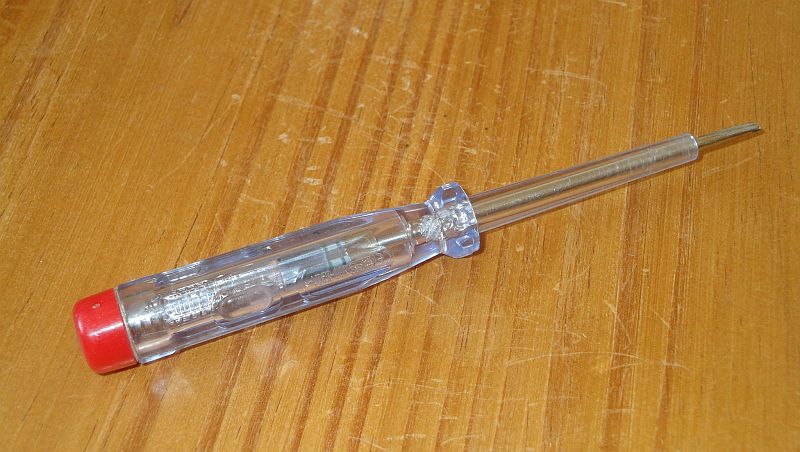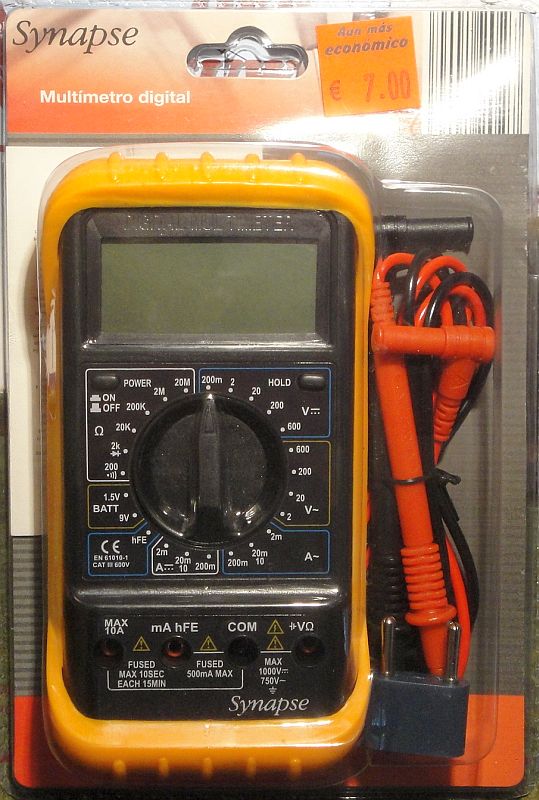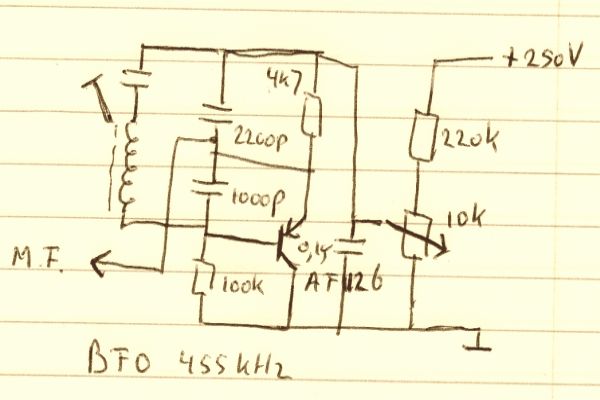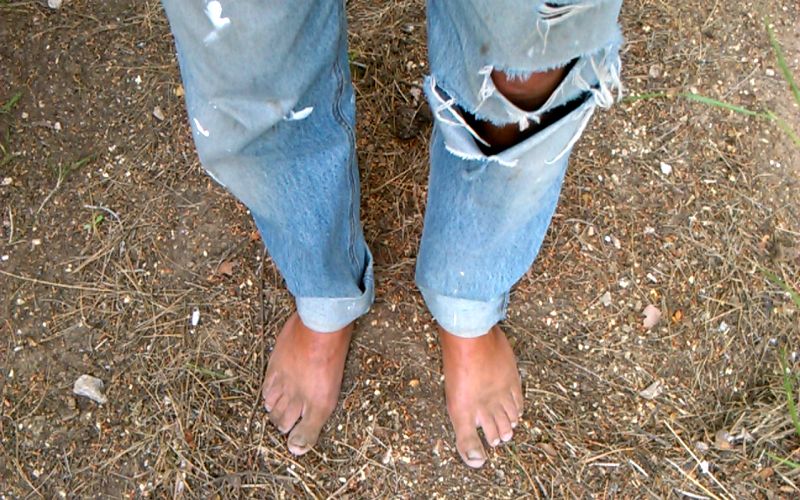MEASURING INSTRUMENT FOR A POOR STUDENT!
(1973)
KLIK HIER VOOR DE NEDERLANDSE VERSIE
It started with the repair of a tube radio
A very simple and inexpensive measuring instrument for a "poor student" for repairing radios with tubes! I had not expected that I would get a measurement device fot it that day, because measuring instruments were very expensive. I had to fix a tube radio, no sound at all, and thought that it was a faulty final tube. So to Alex, a boy from an Eastern European country who traded in old radios and televisions and parts.
"Why should I wear shoes if I can walk barefoot? It is also healthier!" he said. Indeed, simplifying processes is currently a hot topic, but he knew it already then. "And as a son of a poor farmer I am used to go barefoot. When it was not too cold, I even played barefoot in the snow! Sometimes we were hungry and then my father and uncle threw a chain over the overhead powerline into the water. Then the village did not have power for a while, but we had fish to eat and we traded that for bread! But I would never do that because I'm very careful with electricity. I live for free this abandoned old house to protect it from vandalism." He kept talking with that funny accent. "We got difficulties, and my father has brought me here. The Queen is a very kind woman, she allowed me to stay here."

I could not pay this measurement instrument.
I told him that I thought that the problem was a faulty final tube, but that I, being a poor student, could not buy all those expensive instruments to measure it. "You may be a clever student, but I, simple son of a poor farmer will teach you with what simple measurement instrument you can repair tube radios. You can use it as a voltmeter and as a signal injector." he said.
The doorbell rang. A moment later he came back. "I have repaired their portable radio. Free. The screws of the tuning capacitor were loose, just tightening them and tooth washers underneath. In the radio shop they said that the radio could not be repaired anymore, but they had to pay investigation costs! But in the shop, they did not even look at it, because you have to damage a little sticker to open it and that sticker was undamaged!"

With a voltage tester you can find almost every fault in a tube radio!
No simple measurement instrument to see, only a voltmeter. Then he showed me a voltage tester screwdriver! He told me how you can use it. How simple! I was surprised. Why had I not found that out!!! "Take the voltage tester with you. Free!" he said. "But when you do repair radios with U-tubes, you should not do that barefoot but with insulating safety shoes! Certainly on this concrete floor! Because the chassis is connected to the mains when you have plugged the plug incorrectly in the socket. You can also test that with this measurement instrument. Maybe you can use those ordinary shoes, with the simple measurement instrument you can measure if the insulation is high enough! I have an isolation transformer, then I can always work safely."

But I could pay this simple measurement instrument!
It is a voltmeter and a signal injector!
So the measurement instrument is a simple voltage tester screwdriver!
How simple, an ordinary voltage tester! You can use it as a voltmeter and also as a signal injector! It can measure AC and DC voltage. The brighter the light, the higher the voltage. Take the voltage tester in one hand and touch with the other hand the chassis of the receiver. You can measure the supply voltage, then the LED should light up brightly. And also for the anode voltage of the final tube. But less bright for other tubes with an anode resistor. And also less bright at screen grids with resistors. Often these resistors are increased in value, then the light is quite weak.
You can use it to shorten a grid to ground in order to test whether the defect is before or after that point. And you can also repair plugs with it! And... many more like... Think about that yourself!
Also usable as a signal injector!
But you can also use it as a signal injector! Put your finger again on the back of the voltage detector, but keep your other hand clear of the chassis. Press the voltage detector on the grid of the final LF tube and you will hear hum. Go further back in the the receiver. On the previous LF stage, the hum has to be already louder. And it also works on the IF and RF stages. On the grid of the IF amplifier, the hum has to be louder and on the grid of the mixing tube even more louder. Why it works on the IF and RF stages, I do not know. Perhaps that the neon lamp generates much with the mains frequency modulated noise on the IF frequency. But it definitely works! Start at the final tube and go back to the mixer stage. If the signal stops, you're at the faulty amplifier stage.
What a huge improvement and simplification of the fault finding process! Much cheaper, easier and much faster! And is it possible to blow up measurement equipment, such a voltage divider is indestructible!

Times have changed. Nowadays you can buy an excellent digital voltmeter
for hardly no money in... the supermarket!
More tips!
The next day, the defect was found. It was not the final tube but the rectifier tube. At the input was supply voltage, but not at the output, but he tube glowed, very
strange! I told enthusiastic that I succeeded to find the fault. I got that tube for free. Did he have more tips? Yes!
- You can also measure high-frequency voltages in transmitters and adjust the various stages at maximum power with it! And to measure field strength. In a high-frequency field near an antenna the lamp will light!
- If you have a radio receiver with U tubes, the chassis is connected directly to the mains. Then the plug should be connected to the socket so that the chassis is connected to the neutral. And that can be tested with the simple voltage tester!
- Set the receiver that you have to repair close to another one that is tuned to a station on a high frequency in the medium wave band. For example Veronica on 192 meters. Tune the receiver that you have to repair to a frequency that is 455 kHz lower, you should hear a loud tone of which the pitch changes with the tuning. Then you know that the oscillator of the mixer stage works.
- And if the anode of the final tube is red coloured, it draws too much current. Shorten the grid to ground. If the red color disappears, then the
coupling capacitor with the previous tube is defect. If not, then the electrolytic capacitor across the cathode resistor is defect, cut it loose, and set the volume slightly higher is the solution.
- For a FM receiver, you can keep a wire close to the input of the IF stage. If you hear shortwave transmitters, everything from that point is correct. Does not always work at night, because there are often no reception conditions at 10.7 MHz at that time of the day.
- Take a resistor with insulated wires with you during repairs. Connect that in parallel to the screen grid resistance of the IF stage. If the volume does increase considerably, then replace the screen grid resistor. And also take a (high voltage) electrolytic capacitor with you.
- You do not need a signal generator, you can receive enough radio stations that you can use. A broadcast transmitter at a low frequency for adjustment of the coil of the input circuit at maximum, and another broadcast station at a high frequency for adjustment of the trimmer. I have tremendously improved many receivers by adjusting the trimmer at maximum for the then popular transmitter Veronica on the frequency of 192 meters at the end of the scale.
- And ... always start with to look, feel, smell and... listen! Cracking sounds, beeps, noise, hum and distortion... you can hear that with you ears, you do not need an expensive distortion meter!
And how can I measure the insulation of my shoes? "I am barefoot here on the stone floor and the voltage detector light is bright. But you with your shoes the light is less bright, so your shoes have sufficient insulation!"

BFO for the tube radio.
With the potentiometer, the level can be controlled (rotate to zero for off).
The wire is mounted close to the grid of the first MF tube.
I also tried to walk barefoot in the snow as Alex did. It was possible, after a few times I did not understand why it was so unbearable cold the first time!
Later I got a tube radio with marine band from him. A wonderful device with additional RF stage and 3-fold tuning capacitor. Listening to the marine band conversations was nice. Later I built a BFO for SSB reception in it. To thank him, I helped him with the maintenance of the garden. On Wednesday afternoons, when he was at work. Great, all alone at the countryside. Of course not with my good shoes, but very simple and cheap on my bare feet! Because I remained a poor student. I did not become rich from all those repairs... And cleaning my toe nails could also be done with that new measuring instrument!

Poor student at work
BACK TO INDEX PA2OHH






